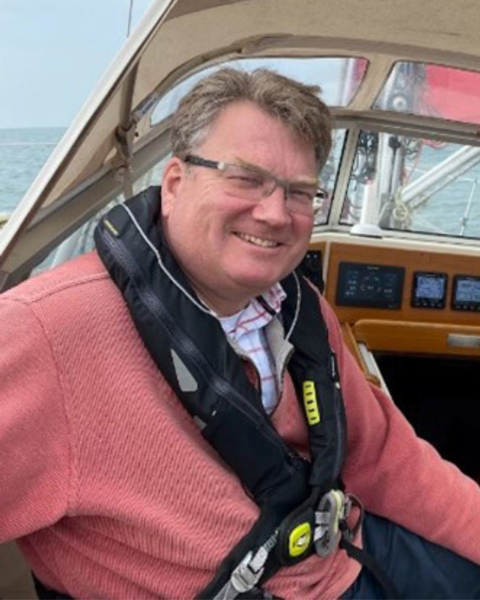
In Focus: Raymarine’s seizing automated opportunities
“More automation onboard will take away the risk of boating,” says Andy King, Raymarine’s VP of sales. It’s a future that the sensor company is looking forward to – being as it’s positioned itself to provide what’s needed.
“The way the market is going is an opportunity for Raymarine,” King says. “Tech is moving so quickly but Raymarine is in a good place because we’re a sensor company – sonar, radar, AIS, visual & thermal cameras, all with marinized hardware. Whatever happens, for example in screen technology, we’re still going to need all of those sensors.”
Raymarine is seizing that opportunity with its latest pairing. While the company essentially builds hardware (with embedded software), it’s now collaborating closely with a Hyundai subsidiary, via software company AVIKUS.
The pair demoed NeuBoat Dock at IBEX. This is a 360-degree vision system featuring six cameras which feed into what King describes as ‘cutting edge auto parking’. He says the system will enable a boat to manoeuvre through a river into a marina and then dock . . . totally autonomously.
“What we are showed at IBEX is the boat can park itself on the dock totally autonomously. It’s uncanny, you’re on a boat and it’s manoeuvring itself and parking itself. Combining our sensors and their [AVIKUS] software, you can do these amazing things.”
Neuboat 360-degree vision system will be available for boat builder partners in Q4, 2023. The autonomous parking is a future upgrade, that Raymarine can demonstrate, but will not be available for sale for some time.
King says that, meanwhile, DockSense Control will continue, as it performs a different function. The latter gives a radar like image around the boat and controls the movement of the boat, using the installed joystick system to prevent to boat from hitting anything. When the boat gets to within a pre-determined distance of the dock, the boat stops and holds position.
Neuboat comes on the back of Raymarine’s other innovations like its augmented reality which it launched in 2019. That combined data from its sensors with other information like locations of other boats, marinas, restaurants, and buoys.
“They’re all outlined on the camera view,” says King. “Innovation brings it all together in an augmented reality. You can literally tap a restaurant on a chart and follow the way with camera points. It’s 3D augmented reality in a marine space, and it works at night.”
Supporting the expected buy-in from boaters for ease, ease and more ease will be the company’s network of around 3,000 service dealers. In 2007, Raymarine acquired some of its distributors which are now subsidiary offices. The strategy was to get closer to boatbuilders and dealers and its been a success, says King. Now Raymarine is part of FLIR, which sits with Teledyne Technologies.

“Raymarine’s a small cog within Teledyne,” says King (pictured). “But our service dealer network is just as important and is still well maintained.
“Our service dealers must be trained at least once every two years in order to be authorised to do installations and repairs.” And it’s important that they get it right as Raymarine offers – with the right warranty sign-ups – global back-up. Given that the company will send an engineer to a boat, pay for the time spent onboard and the travel, and source the replacement product, the network needs to be able to perform.
“But the vast majority of our customers are going sailing ‘next weekend’,” quips King, rather than circumnavigating the globe, “it’s important they want their equipment fixed – but it’s not life threatening. But they still want a very quick turnaround of getting the product fixed.”
That said, King notes that while there is good support in the field, there is “lots of effort designing products to last. We can’t afford to have them failing.” With this in mind, Raymarine tests its products to destruction. “We drop, heat, cool, spray (with a fireman’s hose for pressure), and submerge them to test all potential scenarios. We ask our suppliers to improve their products and then we test again for the marine environment.”
King also says that, unlike many tech-heavy companies, Raymarine isn’t collating data on its customers.
“There’s very little data collected. I’d imagine Apple knows everything about how you use its products, but we do not. With permission, we record bathymetric data – to build up more accurate charts. But things like Yachtsense – our system which communicates to the cloud and creates its own boat wifi network – is only accessible by the owner of the account. They can see where the boat is, the engine hours etc.
“At some point charter companies and boat builders might hope to create a data community with cloud data becoming accessible. But the GDPR hoops are still there.”
(Raymarine’s YachtSense Ecosystem enables complete onboard and offboard integration with all devices connected to the boats network. An installed system assures captains and boat owners of the readiness of their vessel prior to, during and after their voyage.)
The post In Focus: Raymarine’s seizing automated opportunities appeared first on Marine Industry News.
